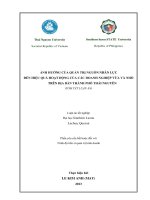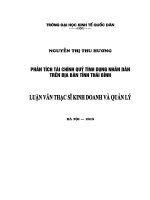Tác động của quản trị nguồn nhân lực đến hoạt động sản xuất kinh doanh của các doanh nghiệp vừa và nhỏ trên địa bàn tỉnh thái nguyên
Bạn đang xem bản rút gọn của tài liệu. Xem và tải ngay bản đầy đủ của tài liệu tại đây (1005.67 KB, 111 trang )
Southern Luzon State University
Republic of Philippines
IMPACT OF HUMAN RESOURCE MANAGEMENT PRACTICES ON
ORGANIZATIONAL PERFORMANCE IN SMALL AND
MEDIUM ENTERPRISES IN THAI NGUYEN CITY
A Dissertation
Presented to
The Faculty
Graduate School
Southern Luzon State University
Lucban, Quezon
In Partial Fulfillment
of the Requirements for the Degree
Doctor of Business Administration
by
LE KIM ANH (MAY)
2013
APPROVAL SHEET
In partial fulfillment of the requirements for the degree Doctor of Business Administration,
this research study entitled “Impact of Human Resource Management Practices on the
Organizational Performance of the Small and Medium Enterprises in Thai Nguyen
Province” has been prepared and submitted by Le Kim Anh and is hereby recommended for
oral examination.
............, 2013
Alice T. Valerio, Ph.D.
Adviser
Approved by the Oral Examination Committee, in partial fulfillment of the requirements for
the degree Doctor of Business Administration offered by Southern Luzon State University,
Republic of the Philippines in collaboration with Thai Nguyen University, Socialist Republic
of Vietnam.
(NAME OF PROFESSOR)
(NAME OF PROFESSOR)
Member
Member
(NAME OF PROFESSOR)
Chairman
Accepted in partial fulfillment of the requirements for the degree Doctor of Business
Administration offered by Southern Luzon State University, Republic of the Philippines in
collaboration with Thai Nguyen University, Socialist Republic of Vietnam.
____________
Date
APOLONIA A. ESPINOSA, Ed.D.
Dean, Graduate School
ACKNOWLEDGMENT
Writing a doctoral dissertation is a gratifying but difficult and sometimes nerve
wrecking endeavor that only few engaged in because it requires a lot of sacrifices and hard
work from the researcher. However, at the end of the task, one experiences a wonderful
feeling of joy, happiness, relief and fulfillment.
The researcher would like to extend her sincerest gratitude and thanks to the following
people who were very instrumental in the fulfillment of this research study.
DR. CECILIA N. GASCON, President of the Southern Luzon State University in the
Republic of the Philippines, for her untiring effort and belief that this collaboration is possible
thus enabling us to pursue the DBA degree;
DR. DANG KIM VUI President of Thai Nguyen University in the Socialist Republic of
Vietnam, for his untiring effort and belief that this collaboration is possible thus enabling us
to pursue the DBA degree
DR. NGUYEN TUAN ANH, Ph.D., former Director of the International Training
Center, Thai Nguyen University of the Socialist Republic of Vietnam, for his enormous
pursuit to provide the Vietnamese people an opportunity to grow through education;
DR. ALICE T. VALERIO her adviser, for the guidance and endless support for the
improvement of this study.
PROFESSORS ………….., ………………., and ……………, who composed the Oral
Defense Committee, for their suggestions, comments and corrections to improve this study;
ITC STAFF, for providing the necessary research materials;
HER FAMILY and FRIENDS, for the love and support in one way or the other;
And TO ALL who have contributed to make this study a success.
iii
DEDICATION
This research is wholeheartedly dedicated with all sincerity and love to my
FAMILY…..
To my Mum and Sun who provided me with love and care.
To ALL OF THEM…I humbly dedicated my work and success in life.
iv
Table of Contents
Page
Title Page
Approval Sheet
ii
Acknowledgment
iii
Dedication
iv
Table of Contents
v
List of Tables
vii
List of Figures
viii
Abstract
ix
Chapter I: Introduction
1
Background of the Study
1
Objectives of the Study
5
Hypothesis
6
Significance of the Study
6
Scope and Limitation of the Study
7
Definition of Terms
7
Chapter II. Review of Literature and Related Studies
Conceptual Framework
10
57
58
Chapter III. Methodology
Locale of the Study
58
Research design
58
Population and sampling
58
Instrumentation
59
Data gathering procedure
60
Statistical treatment
60
Chapter IV. Presentation, Analysis and Interpretation of Data
v
62
Chapter V. Summary, Findings, Conclusions and Recommendations
77
Summary
77
Findings
77
Conclusions
79
Recommendations
80
Bibliography
81
Appendices
90
vi
LIST OF TABLES
No.
Name of tables
1
Table 4.1.1. Percentage Distribution of Respondents’ Profile in Terms
of Type of Industry and Ownership
2
Table 4.1.2. Percentage Distribution of Respondents’ Profile in Terms
of Business Characteristic
3
Table 4.3.1. The Assessment of Respondents on HRM in Terms of
Recruitment and Selection
4
Table 4.32. The Assessment of Respondents on HRM in Terms of
Training and Development
5
Table 4.3.3. The Assessment of Respondents on HRM in Terms of
Career Planning System
6
Table 4.3.4. The Assessment of Respondents on HRM in Terms of
Participation and Involvement
7
Table 4.3.5. The Assessment of Respondents on HRM in Terms of
Compensation and Benefits
8
Table 4.3.6. The Asessment of Respondent on HRM
Performance Appraisal
9
Table 4.3.7. Perceived Organizational Performance
10
Table 4.4.1. Variables Included in Analyses
11
Table 4.4.2. Descriptive Statistics
12
Table 4.4.3. Correlations Amongst Variables
vii
Page
in Terms of
LIST OF FIGURES
No.
Name of tables
1
Figure 1. Percentage Distribution of Respondents’ Profile in Terms of
Type of Industry
2
Figure 2. Percentage Distribution of Respondents’ Profile in Terms of
Type of Ownership
viii
Page
Title:
IMPACT OF HUMAN RESOURCE MANAGEMENT
PRACTICES
ON
THE
ORGANIZATIONAL
PERFORMANCE OF THE SMALL AND MEDIUM
ENTERPRISES IN THAI NGUYEN PROVINCE
Researcher:
LE KIM ANH
Degree
Doctor of Business Administration
Name/ Address of the Southern Luzon State University
Institution
Graduate School
Lucban, Quezon
Date Completed
October, 2013
Adviser
DR. ALICE T. VALERIO
ABSTRACT
The study was conducted to assess impact of human resource management
practices on the organizational performance of the small and medium enterprises in Thai
Nguyen Province. A total of 290 managers of the small and medium-sized enterprises in
Thai Nguyen City were selected to be the respondents of the study. It specifically
explored on the profile of the respondents in terms of Types of enterprise; Form of owner
ship; Time of operated; Number of employees. The study was limited to determine the
perception of the respondents on the human resource practices of the small and medium
enterprises in Thai Nguyen City which are classified in aspects namely: Recruitment and
Selection; Training and development; Career planning System; Participation and
Involvement; Compensation and Benefit; and Performance appraisal.
ix
The 290 selected respondents were given a questionnaire designed by the
researcher and complete the questionnaires after being explained and instructed by the
researcher. The researcher floated the questionnaire to the respondents after it had been
validated by her advisor in June 2013.
Recruitment and selection, based on well-defined merit and unprejudiced system
developed through managerial expert opinions, using standardized test to scrutinize the
exact required attitude, skills and knowledge in potential candidates showed notable
significant correlation with employee performance and Perceived Organizational
Performance that identification of the right candidate with required skills to perform the
job for achieving organizational performance is the output of sophisticated selection
system.
Training and development programs in organizations based on training need
assessment, performance appraisal, customization and practically applicable with skills
imparting capability are indicating positive correlation with employee performance and
Perceived Organizational Performance.
A perception that the Career Planning System (CPS) is significantly correlated
with employee performance and Perceived Organizational Performance is true if, the
Career Planning System is based on clear career ladder, aligned goals with organizational
vision, used for succession planning, transparent internal hiring, and equal unambiguous
employment opportunity.
Employee participation related to decision-making process based on opportunities
to make company and self-related decisions, suggestion collection for the betterment of
organization and employee wellbeing as also on appreciation strategy has significant
positive correlation with perceived organizational performance.
x
Compensation system based on expectancy of employees, comparable with
market packages, competency based, performance based, profit sharing based
mechanism, covering both financial and non-financial dimensions, is positively
correlated with perceived organizational performance.
There is a significant relation between Perceived Organizational Performance and
performance appraisal system, that seems based on focused counseling, employee
feedback, transparent disbursement of bonuses, performance based promotions, training
selections and clarity of objectives.
xi
CHAPTER I
INTRODUCTION
Introduction
Human Resource Management is the process of developing, applying and
evaluating policies, procedures, methods and programs relating to the employment,
motivation, maintenance, and management of people in the organization. Human
resources management include activities like strategic HRM, human capital
management, corporate social responsibility, human resource planning, recruitment,
selection, training and development, reward management, performance management,
employee relations, health safety and employee well-being as well as provision of
employee services. It comprises a set of practices and policies designed to maximize
organizational integration, employee commitment, flexibility and quality of work
(Armstrong, 2009).
Effective human resource practices relate to company performance by
contributing to employee and customer satisfaction, innovation, productivity, and
development of a favorable reputation of the firm in the industry. A number of
researchers have reported that HR practices are positively linked with organizational and
employee performance.
Researchers have argued that human resources may be seen as a source of
sustained competitive advantage for organizations (Barney, 1991; Becker & Gerhart,
1996). The underlying assumption is that human resources are unique to the extent that
competitors cannot imitate them. Research has led to the identification of a number of
human resource management practices that contribute to company performance across
different organizations (Huselid, 1995). In a literature review, Delery & Doty (1996)
identified seven such practices that have been consistently considered HRM practices.
1
They defined HRM practices as those that are theoretically or empirically related to
overall organizational performance. These practices include internal career opportunities,
formal training systems, results-oriented appraisals, employment security, participation,
job descriptions, and profit sharing. This approach has come to be known as the “best
practices” or universalistic approach. Within the best practices approach to strategic
HRM, the first practice, internal career opportunities, refers to the organizational
preference for hiring primarily from within. Second, training systems refers to whether
organizations provide extensive training opportunities for their employees or whether
they depend on selection and socialization processes to obtain required skills. Third,
appraisals are conceptualized in terms of outcome-based performance ratings and the
extent to which subordinate views are taken into account in these ratings. Fourth,
employment security reflects the degree to which employees feel secure about continued
employment in their jobs. Although formalized employment security is generally on the
decline, organizations may have either an implicit or an explicit policy. Fifth, employee
participation, both in terms of taking part in decision making and having opportunities to
communicate suggestions for improvement, has emerged as a strategic HRM practice.
Sixth, job description refers to the extent jobs are tightly and clearly defined so that
employees know what is expected of them. Finally, profit sharing reflects the concern for
overall organizational performance on a sustainable basis (Delery & Doty, 1996).
Over the years, researchers have suggested many HRM practices that have the
potential to improve and sustain organizational performance. These practices include
emphasis on employee selection based on fit with the company’s culture, emphasis on
behaviour, attitude, and necessary technical skills required by the job, compensation
contingent on performance, and employee empowerment to foster team work, among
others. Purcell et al., (2003) pointed out that the most successful companies had 'the big
2
idea', they had a clear vision and a set of integrated values. They were concerned with
sustaining performance and flexibility which reveals a clear evidence of positive attitudes
towards HR policies and practices, level of satisfaction, motivation and commitment, as
well as overall operational performance.
Background of the study
Small and Medium Enterprises (SMEs) have been recognized as important factor
of the economy of many countries and Vietnam is not an exception. According to the
data from the ministry of planning and investment of Vietnam SMEs occupied for nearly
85% of the









